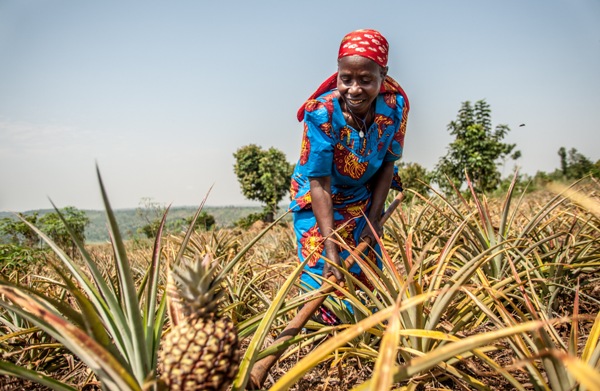
Theresie Nyirantozi in her pineaple farm
Oxfam in Rwanda and the Economic Policy Research Network (EPRN) have co-organized a policy dialogue to collect the impacts of COVID-19 on the horticulture sub-sector and how these have affected business continuity in the same sector.
The dialogue brought together government institutions, Non-governmental Organizations, Community Based Organizations, Development Partners, academicians as well as members of the private sector and media.
The dialogue was based on an independent rapid assessment undertaken between June and July 2020 in eight district of Rwanda (Nyagatare, Kirehe, Musanze, Gakenke, Rulindo, Kamonyi, Muhanga, and Nyamagabe) and surveying farmers and enterprises dealing with 22 various horticulture crops.
Speaking today during the policy dialogue, Dr Charles Ruranga, EPRN’s Chairperson of Board of Directors said: ‘’We are joining Oxfam to reiterate that decisions at various levels need to be taken now, any delay only serves to worsen the already fragile situation of those affected by this global pandemic, and make the recovery process more expensive.’’
Oxfam in Rwanda Country Director, Mrs. Alice Anukur added: “This rapid assessment’s main objective was to collect scientific facts and evidences of the issues faced by horticulture value chains’ stakeholders as they battle the difficult effects of the outbreak of COVID-19 pandemic.
We hope that such dialogues will multiply as we all seek to provide data and strong evidences to various entities for policy formulation and interventions’ programming which will support the many smallholder farmers’ families who are among those who have been mostly affected by this global pandemic.’’
COVID-19 pandemic is bringing not only global health risks, but also unprecedented economic damages and agriculture is among the affected sectors. Prior to COVID-19, Rwandan horticulture sub-sector was playing a crucial role in the country’s economy and it contributed about 50% of non-traditional export revenues and provided income to hundreds of thousands of smallholder farmers.
Fruits and vegetables covered an estimated 1.18% and 0.47% of the aggregate land occupied by all crops in Season A 2020 compared to 1.14% and 0.63% and 6.0% of the previous Season A 2019 (NISR, 2018).
However, the sub-sector is still dominated by smallholder farmers with per capita land size of 0.6 ha; weak market linkages to agribusinesses, limited and non-competitive input providers, processors, and traders. Similarly, weak market- oriented production and aggregation, low value chain development and market connectivity constitute some of the major constraints that the government continues to address. Additionally, women who are outnumbering men in horticultural organizations by significant margin of 56.5% to 44.5% are yet to profit from the benefit of the sub-sector.
The effects of this pandemic have worsened an already delicate sub-sector which was supposed to benefit many women and contribute significantly to reducing poverty and food insecurity in many rural areas of Rwanda.
If decisions are not implemented faster and support provided soon to smallholder farmers and other horticulture value chain actors to respond to the impacts of COVID-19, the situation could become irreversible or remain for much longer and become more expensive to remedy. (End)
